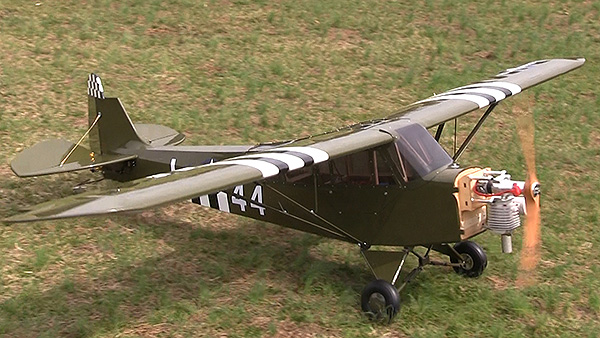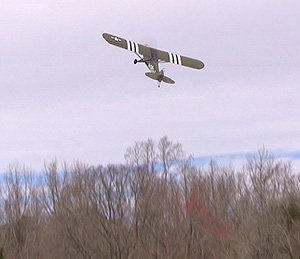



I was short the cowl when I ordered the L-4 so decided to at least maiden it without
one. Good thing I did, I saved a good cowl, eventually.
Text by Tom Hintz
Flight video/images by Gihad Jawhar
Posted – 3-17-2015
Like any maiden day I was anxious to get to the field. This time an all-day rain kept the Bill Hempel ¼-scale L-4 Grasshopper and me home on the first available day. However, a late-day break in the rain let me fire up the new DA-50R in the yard to get the throttle servo adjusted and do some basic carb tuning.
The next day the rain was long gone and I got to the field early to put the Bill Hempel ¼-scale L-4 Grasshopper together and check things over. While I was doing that and waiting for the 10am start time for gas engines the wind started picking up as it so often does in the Carolina’s.
The actual maiden flight started out in some pretty gusty winds but I fly a lot in wind so went ahead. The DA-50R had little trouble getting the Bill Hempel ¼-scale L-4 Grasshopper into the air at about third throttle and pulling it around the field. It needed quite a bit of down trim and a little right aileron but that was all to get it flying relatively straight and level considering the wind it was bucking. This is a huge, thick wing so wind is going to have an effect on it but the Bill Hempel ¼-scale L-4 Grasshopper can fly through that.
As I flew laps around the field I could tell that I would be increasing the control throws. I had used about 25-degrees up and down on the ailerons and elevators and about 30-degrees left and right on the rudder after being warned on the forums that the Bill Hempel ¼-scale L-4 Grasshopper can be “sensitive” to control inputs. Those did work but I am used to flying with all of the throw I can get mechanically on a plane but decided to conservative for the first time because of the sensitivity warnings. Though I had the CG on the 4”-back from the leading edge I often felt like I was using a little too much elevator and wanted to try more throw.

The L-4 certainly wasn't hurting for power
on the maiden as it pitched up and kept
right on going.
Next up I decided to try an aileron roll and it did that pretty well (wind again) but as it came back to upright the DA-50R shut off. The good news is that I had plenty of altitude and was heading downwind next to the field so my first dead stick with the Bill Hempel ¼-scale L-4 Grasshopper was going pretty good.
When I turned the now gliding Bill Hempel ¼-scale L-4 Grasshopper in to the runway it was coming into a stiff and gusting wind and I had no idea how well it glides or loses airspeed. Where I initially thought I might come up a little short of the field I actually had to keep pushing the nose of the Bill Hempel ¼-scale L-4 Grasshopper down for a surprisingly easy landing. Dead-sticks are not a concern with the Bill Hempel ¼-scale L-4 Grasshopper if you don’t panic and have a reasonably smooth place to set it down.
After some hunting and pecking I found a power plug to the DA ignition module had come undone. Fortunately I had screwed the windshield in rather than gluing it so I was able to get at the plug, get it re connected and secured with a plastic clip this time. My bad. The DA-50R fired on the first flip with the ignition connected.
Flight two on the Bill Hempel ¼-scale L-4 Grasshopper went better yet. Despite increasingly gusty winds this plane handles pretty well considering the 105”, thick wing. I tried rolls, inverted flight and knife edge and it does them all. There is a good bit of coupling in knife edge but some of that might have been the even heavier winds aloft so we will wait for a calmer day to work on that.
I was doing landing approaches as well as a few touch and go’s without a lot of trouble in the wind. I was working on keeping the motor in its happy range rather than run it hard during break in but I did do a couple straight up takeoffs and the DA-50R seems like it could care less what it is pulling. It took the Bill Hempel ¼-scale L-4 Grasshopper straight up increasing speed as it went. I only did that for 10 or 15 seconds before throttling back but it is obvious the Bill Hempel ¼-scale L-4 Grasshopper is over powered, just as I like my planes.
After we had shot enough video for this review I wanted to get in a few more flights with the Bill Hempel ¼-scale L-4 Grasshopper. I normally set my planes up with all of the throw I can muster and fly them that way, always have. On a new plane I will set up a couple reduced dual rates that I can click to if the plane turns out to be over sensitive. For some reason I listened to the people telling me this plane could be touchy and I went conservative on the throws. That would bite me quickly.
On one of the touch and goes I bounced the Bill Hempel ¼-scale L-4 Grasshopper a bit and the wind got under it so I nailed the DA-50R to go around. At that same moment a big gust of wind got under the left wing and lifted it abruptly. I jammed the ailerons left but it was too little too late. The right wing hit the runway and the Grasshopper cartwheeled onto its nose. The runway was rain-soaked soft so the prop grabbed and jerked the nose off of the fuselage which was instantly junk. The wings, motor, struts and everything inside are all fine but the Bill Hempel ¼-scale L-4 Grasshopper fuse is a gonner. As of this writing (3-16-2015) parts to fix it appear to be three or more months out.
I will never set a plane up conservatively again because that is just not how I have learned to fly. I know this is not good for all pilots and you have to set your planes up in a way that you are comfortable. From the start I learned to fly with lots of throw and modulating that level of control with my fingers. I am confident that given my normal “excess” control throws I could have saved the Bill Hempel ¼-scale L-4 Grasshopper. But we will never know for sure. It is crashed big time and when it gets fixed it will have my normal big throws in it!
The Bill Hempel ¼-scale L-4 Grasshopper is a good flying plane that begs for a comprehensive instruction manual specifically on this airframe design and size! The lack of any manual at all for this model makes it a tough build for someone that is not familiar with larger airplane systems and assembly. The restricted access to the nose area between the dash and firewall makes some component installation and setup tougher than it needs to be. The area inside the cowl is somewhat cramped but that is strictly because it is a model of a narrow full scale airplane. There is enough room for most engines, especially with compact Pitt’s style mufflers.
The hardware package is good but needs to be more complete and more specifically for this size plane. There were no elevator linkages in the kit I received but there were two extra linkages that I believe were meant for the flaps on a different version of the Cub on which the Bill Hempel ¼-scale L-4 Grasshopper is based. Not having model specific instructions complicates figuring out the hardware even more.
Overall the Bill Hempel ¼-scale L-4 Grasshopper is a good plane that should be fun to fly in light to moderate winds because of the huge wing. This plane is more aerobatic than Piper ever considered but you have to keep in mind what kind of plane you are flying. A big high wing requires different control inputs to do things a mid-wing 3D plane will with hardly any corrective input. On a relatively calm day with moderate control throws the Bill Hempel ¼-scale L-4 Grasshopper can be the best trainer in the land. Crank up the power and control throws and the Bill Hempel ¼-scale L-4 Grasshopper is capable of things this kind of plane should not be capable of.
The Bill Hempel ¼-scale L-4 Grasshopper sells for $600.00 (3-17-2015) with an additional $87.00 in shipping charge to the contiguous 48 states.
Have a comment on this story? –Email Me!